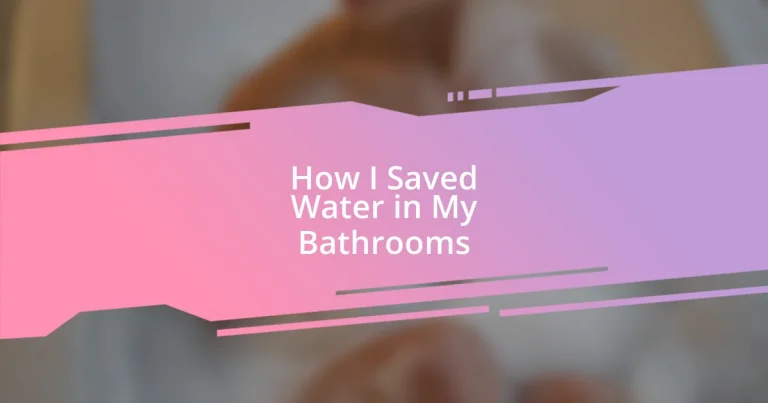Key takeaways:
- Bathroom water usage is significant; long showers and old toilets contribute to high consumption, prompting the need for low-flow options and better habits.
- Identifying and addressing water waste sources, such as leaky faucets and old fixtures, can lead to substantial savings and environmental benefits.
- Implementing smart technologies and regular maintenance checks enhances water conservation efforts, while tracking progress encourages sustainable habits.

Understanding bathroom water usage
Water usage in the bathroom can be surprisingly high. For instance, I remember when I first learned that a single shower can use up to 2.5 gallons of water per minute! Imagine that—taking a long, leisurely shower may feel great, but it can quickly add up. This realization pushed me to rethink my daily routine.
One striking fact that stood out to me was how toilets account for nearly 30% of residential water use. I used to flush without a second thought until I discovered low-flow options. It’s fascinating how a simple change can significantly reduce water waste. Have you ever measured how much water your toilet consumes? You might be in for a surprise!
In my experience, even small changes in habits can lead to meaningful reductions in water usage. I began timing my showers and noticed I could cut my usual 15 minutes down to just 5, which felt surprisingly refreshing! With every drop saved, I felt a growing sense of responsibility and pride. How about you? Have you considered how your bathroom habits impact our precious water resources?

Identifying water waste sources
Identifying water waste sources in my home was an eye-opening experience. I started by taking a close look at my fixtures—sink faucets, showerheads, and toilets. These seemingly innocuous items can be major culprits in my water bill, with leaky faucets dripping away precious water. I tracked a single faucet’s slow drip for a week and was shocked to find it could waste over 3,000 gallons a year!
In addition, I realized the importance of understanding the age and design of my appliances. Older toilets, especially those manufactured before 1994, tend to use up to 6 gallons per flush. When I swapped mine for a modern low-flow model, not only did my water consumption plummet, but my conscience felt a lot lighter, knowing I was making a positive impact.
Lastly, I can’t stress enough the need for regular inspections. A friend of mine discovered a hidden leak behind his wall that had gone unnoticed for months, wasting hundreds of gallons. This personal experience reinforced my belief that vigilance is key. Have you checked your home for hidden sources of waste? You might just uncover shocking amounts of water being lost every day.
| Source of Water Waste | Average Water Use |
|---|---|
| Leaky Faucet | 3,000 gallons/year |
| Old Toilet | 6 gallons/flush |
| Showerhead (Standard) | 2.5 gallons/min |

Installing low flow fixtures
I discovered that installing low-flow fixtures in my bathrooms was an incredible way to save water without sacrificing comfort. I remember the moment I decided to replace my traditional showerhead. The new one had a flow rate of just 1.8 gallons per minute—a difference I could hardly believe! As I stepped into the shower that first time, I was amazed. It felt just as refreshing, and I enjoyed the added benefit of knowing I was saving water with every rinse.
Here are some low-flow fixtures that have made a huge difference in my home:
- Low-flow showerheads: These maintain pressure while using significantly less water.
- Dual-flush toilets: Offering a choice between a low-volume flush and a standard flush can cut water usage in half.
- Aerators for faucets: These simple additions mix air with water, reducing flow without compromising performance.
I can’t help but feel a surge of satisfaction seeing my monthly water bill decline. It’s a tangible reminder that small changes can have a big impact. Every drop saved feels like a step toward making a difference for our environment, and I invite you to consider making this change in your bathrooms as well.

Using water-saving habits
One of the simplest water-saving habits I adopted was shortening my shower time. I used to enjoy long, leisurely showers, but I set a timer for just 5 minutes. It was surprising how refreshing a quick shower could be! I actually began to look forward to those invigorating moments, and now, it feels rewarding to know I’m saving water and still feeling clean.
I also made it a practice to turn off the tap while brushing my teeth. Honestly, I never realized how much water I was wasting just letting it run. Now, with the water off, I have more awareness of my everyday actions. Have you ever stopped to think about how much water you could potentially save with this one simple change? It’s quite astonishing!
Finally, I embraced the habit of running full loads when washing clothes or dishes. This not only optimizes water usage but also maximizes efficiency. I reflect on those days when I would wash just a few items and cringe at the thought of wasted water. Committing to this habit felt like part of a larger journey toward sustainability. Seeing my efforts materialize in my water bill only solidified my commitment. How about you? What small changes can you make today?

Implementing smart technology solutions
The introduction of smart technology has revolutionized the way I manage water in my bathrooms. For instance, I installed a smart shower system that allows me to monitor water usage in real-time through my phone. It’s astonishing how much more mindful I’ve become about my water consumption; now, I’m always aware of when that little meter hits the red zone!
Additionally, I’ve incorporated smart faucets that have motion sensors. No more leaving the water running while I scrub my hands! I remember how often I’d get distracted and waste water, but this simple technology has truly transformed that habit. It not only conserves water but adds a touch of modern convenience to my daily routine.
Finally, utilizing a smart water monitor gave me insights into overall water usage patterns within my home. I was surprised to see how usage spiked during certain times of the day. Have you ever thought about how identifying those trends could help you save even more? Now, I can adjust my habits accordingly, making my efforts more intentional and effective. It’s these small tweaks, coupled with smart solutions, that really amplify my impact on water conservation.

Regular maintenance checks
Regular maintenance checks in my bathrooms have been a game-changer for saving water. One day, I noticed that the toilet tank was leaking a bit, which I initially shrugged off as a minor issue. However, after a quick inspection, I realized that even a small leak can waste gallons of water every day! Addressing that minor problem not only gave me peace of mind but also significantly lowered my water bill.
Something as simple as checking faucet aerators can make a difference too. When I took the time to inspect mine, I found that one faucet was functioning poorly due to mineral buildup. After a thorough cleaning, not only did the water flow improve, but I also found myself using less water overall. It’s amazing how often we overlook these details in our daily lives. Have you ever examined your taps for optimal performance? A little routine maintenance can lead to big savings, both environmentally and financially.
I also make it a habit to look under the sinks regularly. I can’t tell you how many times I’ve discovered damp areas that hinted at leaks. Each time, taking action—whether it was tightening a fitting or replacing a worn-out washer—made me feel proactive and responsible. Catching these issues early creates a sense of effectiveness in my water-saving efforts. Have you thought about what lies beneath your sink? Taking a moment to check can prevent future headaches and help preserve this precious resource.

Tracking water savings progress
Tracking my water savings progress has been an eye-opener. At first, I relied on a simple notepad to jot down my monthly water bill, but soon I realized that wasn’t enough. I started using a dedicated app that tracks my usage in real-time, which lets me see exactly how much water I save each day. Have you ever watched your savings grow on a graph? It’s incredibly satisfying!
I also noticed that keeping a log of my bathroom habits has been surprisingly helpful. By writing down daily activities like showers, baths, and even how long I let the faucet run while brushing my teeth, I could identify specific behaviors to change. For instance, I discovered that my shower time had crept up until I made a conscious effort to reduce it. Honestly, it was enlightening to see those patterns laid out on paper. What patterns do you think you might uncover in your daily routine?
Another strategy I’ve found effective is setting specific goals for myself. When I aimed to reduce my bathroom usage by 20% in a month, it felt like a challenge worth tackling. I celebrated when I hit certain milestones, such as reducing my shower time from 15 to 10 minutes, and that not only felt rewarding but also motivated me to keep pushing forward. Setting tangible targets made the process more engaging and helped me stay committed to my water-saving journey. Have you set any personal goals for conserving water? If you do, I assure you, tracking those victories can be incredibly empowering!














